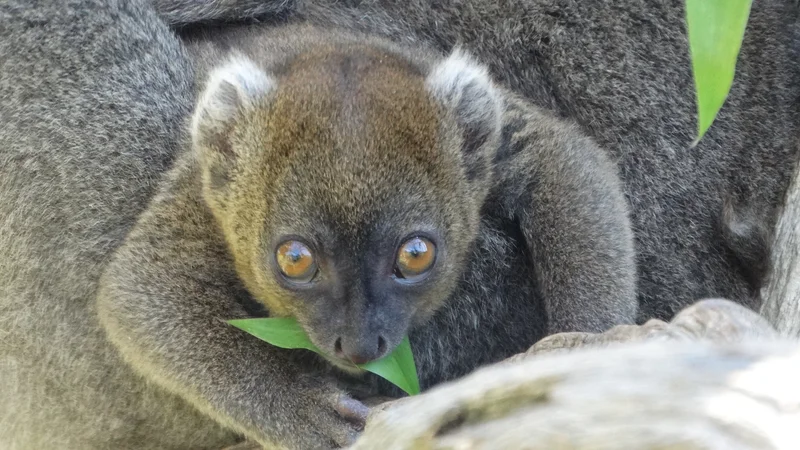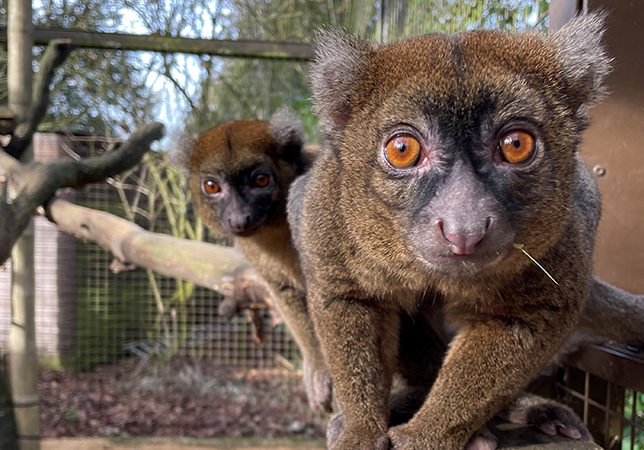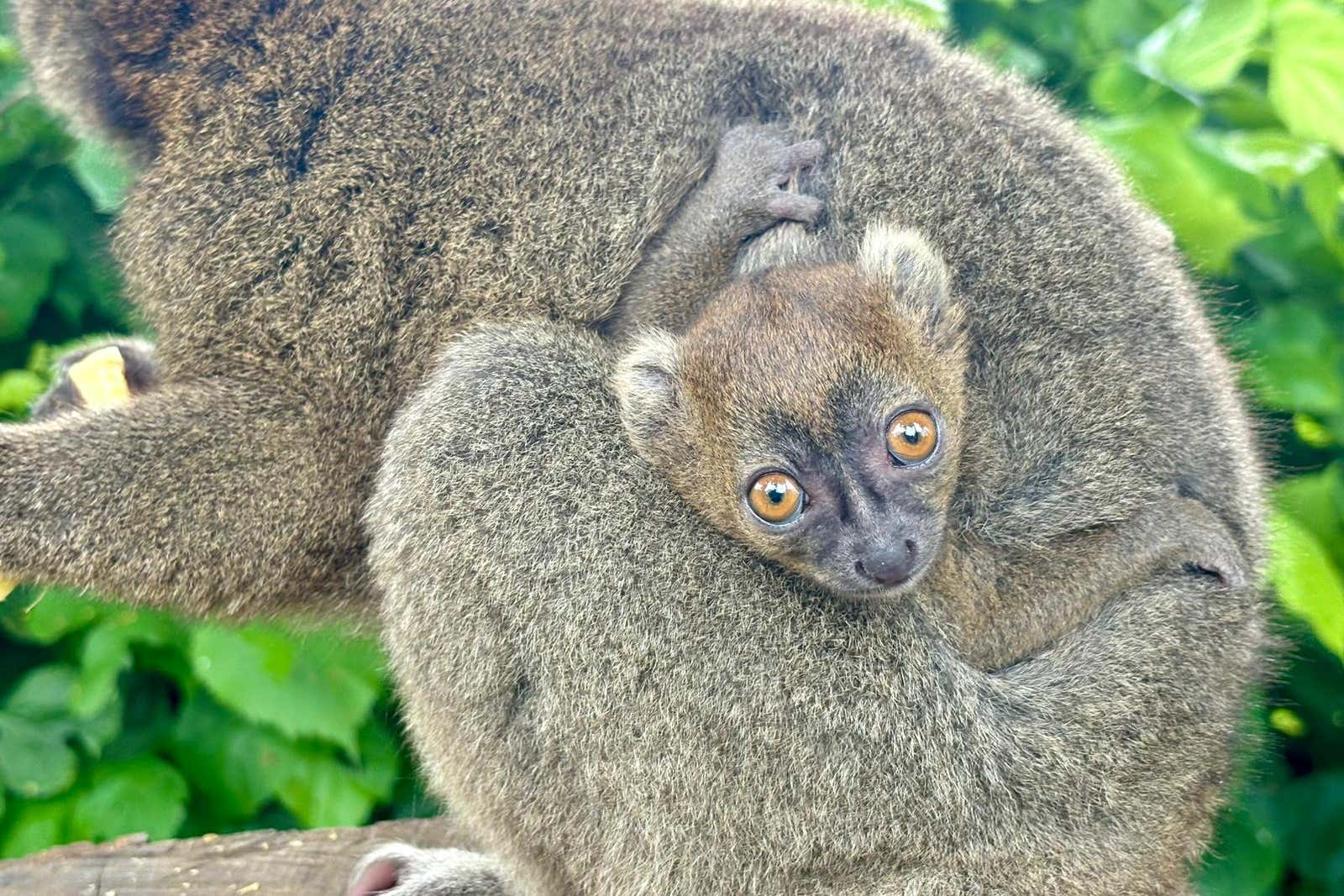A rare and critically endangered species of lemur, the greater bamboo lemur, has recently been successfully bred at the Cotswold Wildlife Park in the UK. This is an important milestone not only for the park but also for global conservation efforts.
The birth of the unnamed lemur, whose sex is still unknown, highlights the ongoing need to protect these unique primates that face significant challenges due to habitat destruction and human encroachment in their native Madagascar.
With only 36 greater bamboo lemurs in captivity worldwide, this achievement marks a crucial moment in the battle to preserve one of Madagascar’s most endangered species.
Lemur Born at Cotswold Wildlife Park
The greater bamboo lemur (Prolemur simus) is one of the most endangered lemur species in the world, and its survival is heavily dependent on both in-situ and ex-situ conservation efforts. Native to the tropical rainforests of Madagascar, this species is critically endangered primarily due to habitat loss.
The forests of Madagascar have been severely impacted by deforestation, slash-and-burn agriculture, and logging, which have reduced the natural habitat of the greater bamboo lemur by over 80% in recent decades.
Read : Madagascar: The Enchanted Island of Unique Wonders
The greater bamboo lemur’s diet is highly specialized, consisting almost exclusively of bamboo, which makes them even more vulnerable to habitat destruction.
They rely on large tracts of bamboo forests for their sustenance, and as these forests are cleared for farming or construction, the lemurs are left with fewer resources to survive. Moreover, the rapid rise in Madagascar’s human population has exacerbated these threats, pushing the species closer to extinction.
Read : Wild and Wonderful: A Journey through Earth’s Most Unique Creatures
Classified as “critically endangered” by the International Union for Conservation of Nature (IUCN), the global population of greater bamboo lemurs is estimated to be fewer than 1,000 individuals, with the majority residing in isolated pockets of forest.
This makes conservation programs like the one at Cotswold Wildlife Park essential for their survival. By breeding these animals in captivity, zoos and wildlife parks help ensure the survival of the species, should the population in the wild continue to decline.
Cotswold Wildlife Park’s Conservation Efforts
Cotswold Wildlife Park, located in Oxfordshire, UK, has played a significant role in the conservation of the greater bamboo lemur, becoming one of only two zoological collections in the world to have successfully bred the species this year.
The park’s breeding pair, Raphael (the male) and Bijou (the female), are part of a European breeding program aimed at preserving the species. Over the past four years, Cotswold Wildlife Park has successfully bred these lemurs, making them a key player in global conservation efforts.
The birth of this new lemur, though still unnamed, is a remarkable achievement considering the rarity of greater bamboo lemur births in captivity.
There are only 36 individuals in captivity globally, spread across seven zoological collections. The fact that Cotswold Wildlife Park is home to one of the few breeding pairs highlights the importance of their work in preserving this species.

The park’s efforts go beyond breeding, however. Jamie Craig, the park’s general manager, has emphasized the importance of raising awareness about the plight of lemurs and the threats they face in the wild. Cotswold Wildlife Park not only participates in breeding programs but also funds conservation projects in Madagascar.
These projects aim to protect the remaining habitats of the greater bamboo lemur and to promote sustainable land-use practices that can coexist with lemur conservation.
The Cotswold Wildlife Park Conservation Trust plays a central role in these efforts, providing financial support to key conservation sites in Madagascar. These partnerships are crucial in the fight to save the greater bamboo lemur from extinction.
The park’s lemur exhibit, Madagascar, serves as both a home for these endangered creatures and as an educational tool, allowing visitors to learn more about the species and the threats they face in the wild.
The Importance of Zoos in Conservation
The role of zoos and wildlife parks in modern conservation cannot be overstated. In the case of the greater bamboo lemur, captive breeding programs are vital for ensuring the species’ survival.
With the natural habitat of these lemurs rapidly disappearing, zoos serve as a safety net, maintaining a population that can one day be reintroduced into the wild if conditions improve. Additionally, zoos play a critical role in educating the public about endangered species and the importance of conservation.
Cotswold Wildlife Park, for example, not only provides a home for endangered species like the greater bamboo lemur but also raises funds and awareness for conservation projects in Madagascar. By allowing visitors to see these rare animals up close, the park helps foster a connection between people and wildlife, encouraging them to support conservation efforts.
The lemur exhibit, in particular, allows visitors to learn about the challenges these primates face and how they can help through donations or by supporting conservation organizations.

Conservation efforts in captivity also provide valuable research opportunities. Studying lemurs in a controlled environment allows researchers to better understand their behavior, diet, and reproductive habits, which can be used to inform conservation strategies in the wild.
In the case of the greater bamboo lemur, understanding their highly specialized diet of bamboo has helped conservationists identify key areas of forest that need protection to ensure the species’ survival.
The European breeding program that Cotswold Wildlife Park participates in is a coordinated effort to manage the captive population of greater bamboo lemurs across multiple zoos. By working together, zoos can maintain genetic diversity in the captive population, reducing the risk of inbreeding and ensuring a healthy population that can be sustained over the long term.
A Glimpse into the Future of Lemur Conservation
The birth of this new lemur at Cotswold Wildlife Park offers a glimmer of hope for the future of the species. However, the challenges facing the greater bamboo lemur are far from over.
Habitat destruction in Madagascar continues at an alarming rate, and without significant efforts to protect the remaining forests, the species could face extinction in the wild within the next few decades.
Conservationists are working tirelessly to change this outcome. In addition to captive breeding programs, organizations are working to protect critical habitats in Madagascar by promoting sustainable land-use practices that benefit both local communities and wildlife.

Reforestation projects, community education, and efforts to reduce illegal logging are all part of the strategy to preserve Madagascar’s unique biodiversity.
The greater bamboo lemur is just one of many species of lemur that are facing extinction. Madagascar is home to over 100 species of lemurs, and nearly all of them are threatened by habitat loss and other human activities. The island’s unique ecosystems are incredibly fragile, and once lost, they cannot be easily restored. This makes the work of organizations like Cotswold Wildlife Park and their partners in Madagascar even more critical.
The birth of a critically endangered greater bamboo lemur at Cotswold Wildlife Park is a significant achievement for global conservation efforts. It highlights the vital role that zoos and wildlife parks play in preserving species that are on the brink of extinction.
While the challenges facing the greater bamboo lemur and other endangered species in Madagascar are immense, the ongoing work of dedicated conservationists offers hope for a brighter future. Through captive breeding, habitat protection, and public education, we can work to ensure that future generations will continue to share the planet with these remarkable creatures.

